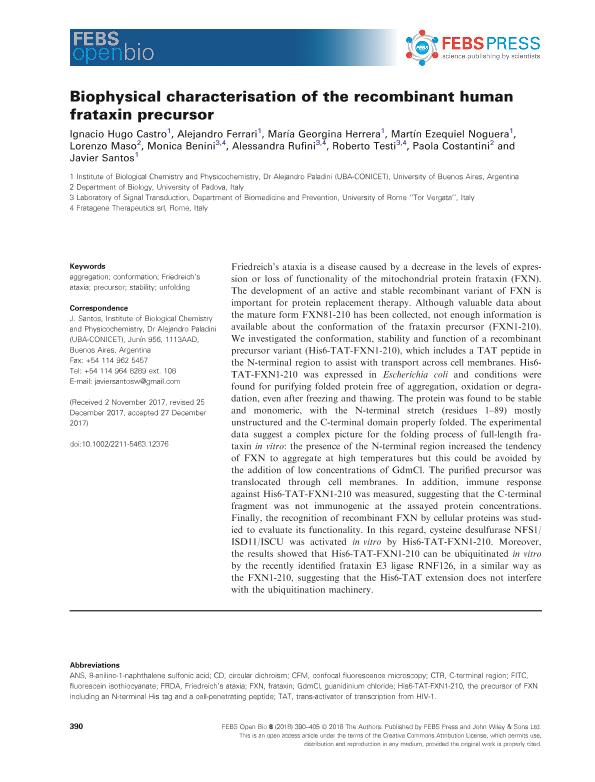Artículo
Biophysical characterisation of the recombinant human frataxin precursor
Castro, Ignacio Hugo; Ferrari, Alejandro ; Herrera, Maria Georgina
; Herrera, Maria Georgina ; Noguera, Martín Ezequiel
; Noguera, Martín Ezequiel ; Maso, Lorenzo; Benini, Monica; Rufini, Alessandra; Testi, Roberto; Costantini, Paola; Santos, Javier
; Maso, Lorenzo; Benini, Monica; Rufini, Alessandra; Testi, Roberto; Costantini, Paola; Santos, Javier
 ; Herrera, Maria Georgina
; Herrera, Maria Georgina ; Noguera, Martín Ezequiel
; Noguera, Martín Ezequiel ; Maso, Lorenzo; Benini, Monica; Rufini, Alessandra; Testi, Roberto; Costantini, Paola; Santos, Javier
; Maso, Lorenzo; Benini, Monica; Rufini, Alessandra; Testi, Roberto; Costantini, Paola; Santos, Javier
Fecha de publicación:
03/2018
Editorial:
Wiley Blackwell Publishing, Inc
Revista:
FEBS Open Bio
ISSN:
2211-5463
Idioma:
Inglés
Tipo de recurso:
Artículo publicado
Clasificación temática:
Resumen
Friedreich's ataxia is a disease caused by a decrease in the levels of expression or loss of functionality of the mitochondrial protein frataxin (FXN). The development of an active and stable recombinant variant of FXN is important for protein replacement therapy. Although valuable data about the mature form FXN81‐210 has been collected, not enough information is available about the conformation of the frataxin precursor (FXN1‐210). We investigated the conformation, stability and function of a recombinant precursor variant (His6‐TAT‐FXN1‐210), which includes a TAT peptide in the N‐terminal region to assist with transport across cell membranes. His6‐TAT‐FXN1‐210 was expressed in Escherichia coli and conditions were found for purifying folded protein free of aggregation, oxidation or degradation, even after freezing and thawing. The protein was found to be stable and monomeric, with the N‐terminal stretch (residues 1–89) mostly unstructured and the C‐terminal domain properly folded. The experimental data suggest a complex picture for the folding process of full‐length frataxin in vitro: the presence of the N‐terminal region increased the tendency of FXN to aggregate at high temperatures but this could be avoided by the addition of low concentrations of GdmCl. The purified precursor was translocated through cell membranes. In addition, immune response against His6‐TAT‐FXN1‐210 was measured, suggesting that the C‐terminal fragment was not immunogenic at the assayed protein concentrations. Finally, the recognition of recombinant FXN by cellular proteins was studied to evaluate its functionality. In this regard, cysteine desulfurase NFS1/ISD11/ISCU was activated in vitro by His6‐TAT‐FXN1‐210. Moreover, the results showed that His6‐TAT‐FXN1‐210 can be ubiquitinated in vitro by the recently identified frataxin E3 ligase RNF126, in a similar way as the FXN1‐210, suggesting that the His6‐TAT extension does not interfere with the ubiquitination machinery.
Palabras clave:
FRIEDREICH'S ATAXIA
,
AGGREGATION
,
CONFORMATION
,
PRECURSOR
,
STABILITY
,
UNFOLDING
Archivos asociados
Licencia
Identificadores
Colecciones
Articulos(IQUIFIB)
Articulos de INST.DE QUIMICA Y FISICO-QUIMICA BIOLOGICAS "PROF. ALEJANDRO C. PALADINI"
Articulos de INST.DE QUIMICA Y FISICO-QUIMICA BIOLOGICAS "PROF. ALEJANDRO C. PALADINI"
Citación
Castro, Ignacio Hugo; Ferrari, Alejandro; Herrera, Maria Georgina; Noguera, Martín Ezequiel; Maso, Lorenzo; et al.; Biophysical characterisation of the recombinant human frataxin precursor; Wiley Blackwell Publishing, Inc; FEBS Open Bio; 8; 3; 3-2018; 390-405
Compartir
Altmétricas



